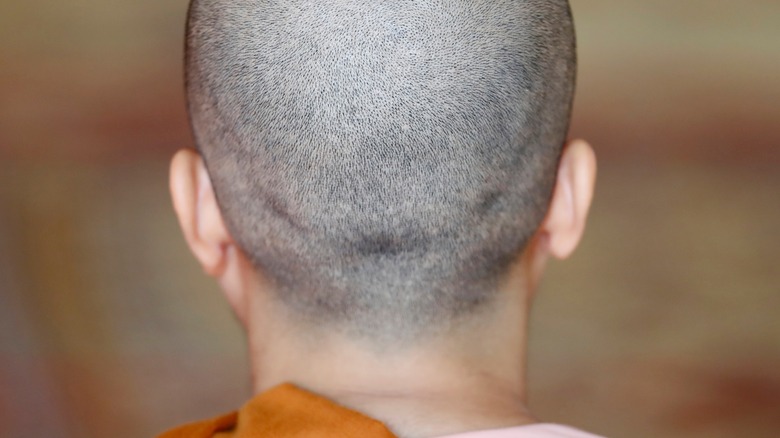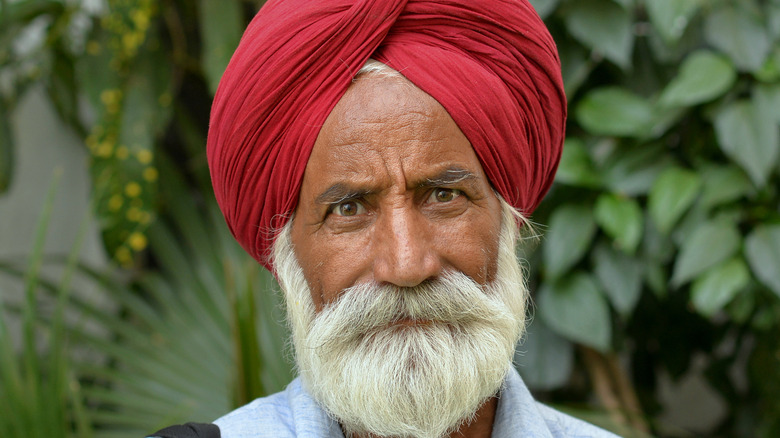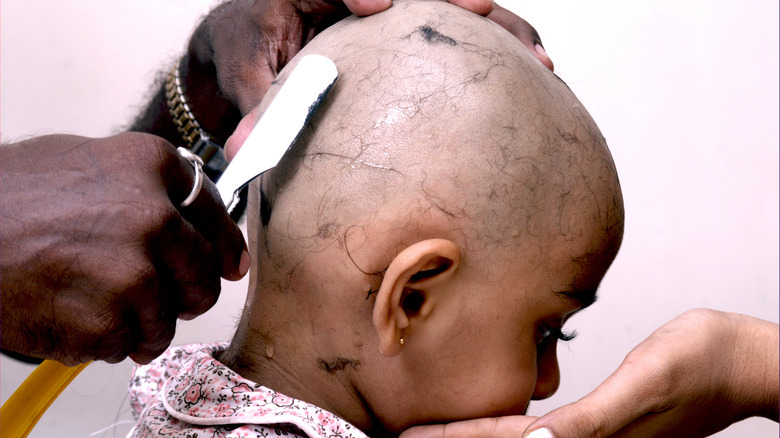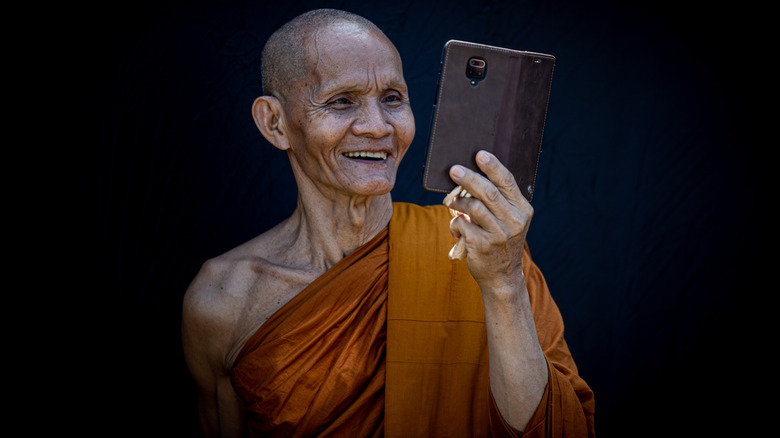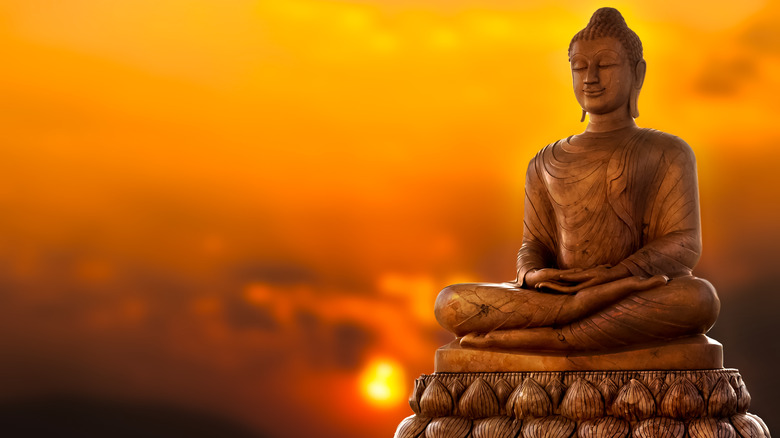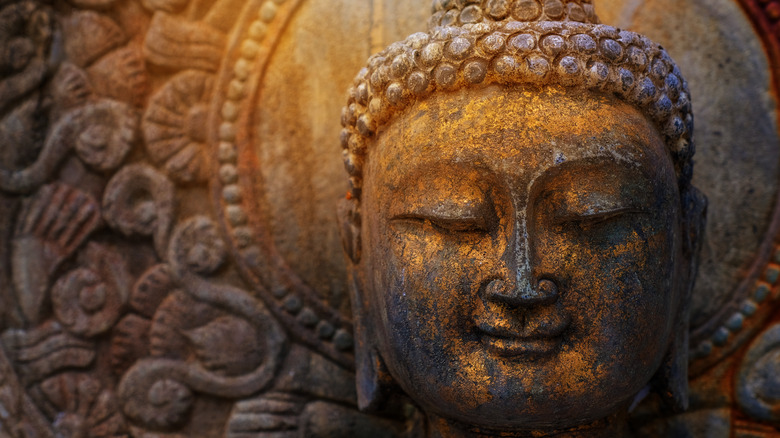Why Some Buddhist Monks Shave Their Heads
Throughout history people have shaved their heads for religious reasons — a haircut called tonsure. The practice includes a full shave or just part of the scalp. But, fixing your hair a certain way for spirituality isn't new. During the first millennium in India, mendicants — religious members who embraced spirituality by not owning any sort of property and sometimes resorted to begging — left their hair deliberately messy, according to Learn Religions. Grooming only occurred after enlightenment was achieved.
Mendicant friars from the Medieval period in Europe also kept this vow to poverty. They hoped to live as Jesus Christ had, traveling the world humbly to spread the word of God, according to the Met Museum. The word mendicant comes from the Latin verb mendicare — to beg.
While not all paths to spirituality insist on poverty, many religions do weigh in on hairstyles. "Hair plays an integral role in the way human beings represent themselves," as author Susan Niditch is quoted on MLive. "It is related to natural and cultural identity, to personal and group anxieties, and to private and public aspirations, aesthetics and passages."
For some, hair is holy
Many religions place restrictions on hair, with some shaving it off and others never cutting it at all. For example, since 1699 Sikh leaders ruled that devotees should not cut their hair at all. Instead, a dastar, or turban, became standard to manage the tangled strands and distinguish Sikhs from all those individuals trimming their locks, according to The New York Times. While some modern Sikhs are now abandoning the practice, many traditionalists want it to stay in place, insisting it symbolizes traits such as holiness, spirituality, and courage.
The Amish are another group that gives special respect to hair, according to Reuters, with Amish men not cutting their beards once they become married and Amish women foregoing hair trims all their life. For the Amish, hair is sacred, symbolic of their faith and part of their practice of humble living.
Orthodox Jewish men look to the Bible for guidance regarding hair, according to Classroom. For example, in the Old Testament, Leviticus 19:27 states that both the hair on the side of the head and the corners of beards should remain unshorn.
Rastafari beliefs also require longer hair in the form of traditional dreadlocks. This practice is partly a nod to the Bible's no-cutting edict. The length allegedly provides strength, just like in the Samson and Delilah story: once a man loses his locks, weakness sets in.
For some, less hair is more spiritual
Of course, the flip side of an abundance of hair is little or none — a practice adopted by other religions. Tonsure, for example, became a common practice in Christianity for both Roman Catholic and Eastern Orthodox clerics entering the priesthood, reported Britannica, until Pope Paul VI abolished it in 1973. Some monks removed part of their hair, creating a monastic crown that resembled the thorns that surrounded Christ's head as he was crucified, said History Answers; it became a symbol of their devotion.
Tonsure is also part of ordination ceremonies in Buddhism, and monks keep their hair shaven. Some places include tonsure as a religious entry point. For instance, in Myanmar and Thailand, boys 8 and older undergo a pravrajyā ceremony, in which they spend some time learning about their spirituality, including hair shaving. A similar experience occurs to young males (roughly 2 years old) in Hinduism during the cūḍākaraṇa ceremony that recognizes the transition from infant to boy. After the traditional shaving, just a puff of hair remains on the head's crown. For those entering the religious life, taking their ascetic orders, full tonsure is required.
The origin of Buddhist head shaving
For Buddhist monks, the idea that hairlessness increases spirituality goes back the practices the Buddha asked his followers to embrace in a section of the scripture Vinaya-pitaka, known as the Khandhaka. The rules listed several hair requirements, including how often you needed to shave it (every two months at minimum), that you needed to use a razor rather than scissors for removal, and that gray hair could not be plucked or dyed. Hair could also not be brushed. Why such specifics? Following these edicts rarely perpetuated vanity, keeping thoughts pure (per Learn Religions).
Even today, the same rules apply to hair, with many ordination ceremonies involving head shaving. Typically, most of the hair is removed before the ceremony, with just a few tufts left to be taken away during the event. The manual razor still remains the tool of choice, since some orders believe electric razors fall under the scissors category — something the Vinaya never wants to touch your hair.
How hair and nails became relics
The three largest schools of Buddhism all have different ideas about how hair should be handled, according to William C. Innes Jr. in his "Buddhism" chapter in "Religious Hair Display and Its Meanings" (via Springer Link). For instance, Siddhartha – the Buddha — took some of his Hindu background into his teaching, such as the idea of body pollution and maintaining a pure lifestyle. After Siddhartha's passing, his hair became a relic and the remnants were treasured in Buddhist shrines.
Even today, the Mahayana School embraces devotional art, and adds hair and nails into their embroidered creations, taking these treasures from holy figures or their family. While tonsuring is advocated by those who practice more monastic Buddhism, some in the Vajrayana School chose to let their locks become long, even dreadlocking them. This is a deliberate action that rejects the old ways and encourages practice in more tantric ways. Not all practitioners do this; the Dalai Lama belongs to Vajrayana Tibetan Buddhism and his head is shaved.
Why is the Buddha depicted with hair?
History conveys that the Buddha joined his disciples in their austere ways, wearing robes and eating what others gave him. Yet, in all the images of the Buddha he's depicted with a cap of curly hair rather than a stark, shaved look. Learn Religions states that the Buddha, though spiritually enlightened, cut his hair, but never necessarily removed all his locks, and told of a story in which one disciple, Upali, gave him a haircut.
The initial depictions of the Buddha appeared about 2,000 years ago and are credited to artists of Gandhara, a kingdom where Pakistan and Afghanistan are found today. These individuals, who were influenced by Greek and Roman culture, portrayed him with his curly chignon. According to Smithsonian Magazine, the ringlets show the Buddha's carefree attitude about the world. The Los Angeles Times offered a similar, but slightly different take: The curly hair represents Siddhartha's shorn topknot, which symbolized his renouncing of his wealthy background. Either way, his hair (or lack of it) showcased his attentiveness to finding a spiritual path — just like so many others.
